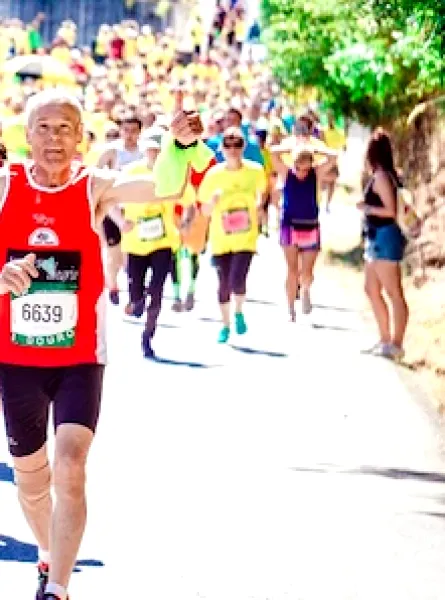
Article by CMI Clinics
You and your friends went to the Eastern Townships last weekend, you weren't really well equipped, fatigue diminished your concentration and a bad fall caused pain in your ankle? In this article, you will learn how to treat a sprained ankle so that you can surprise your friends on your next outing and take full advantage of the benefits of hiking on your body and mind!
If you have ankle pain, make an appointment for a physiotherapy consultation.
Ankle pain after hiking: sprain or not?
Identifying pain is not always easy. In the case of a sprain, the cause of your ankle pain can give a clue as to the nature of the injury. Did they occur as a result of a fall or a false move, or are they unexplained in appearance? If they follow a fall or an uncontrolled movement of your ankle, chances are you have a sprain!
To find out the cause of your pain and to receive a sprain diagnosis, you need to see a health professional.
How to deflate a sprained ankle while hiking?
How do you treat a sprained ankle when you're in the middle of nowhere? That's a question that's worth answering when the opportunity unfortunately arises! Don't panic! We give you 7 recommendations to follow for first aid during a hike!
- First of all, when a sprain occurs, the first thing to do is to rest your ankle. If you have one, sit on your hiking chair. Otherwise, rest on a rock.
- If you are hiking near a stream or creek, apply cold water to your ankle or soak your foot. The cold has pain-relieving properties. It helps to reduce inflammation and numb the pain.
- Elevating your ankle, if possible with the environment, is another recommendation.
- Use compression with a sweater or socks. This helps support the affected ligaments. Be careful not to make your garment too tight, so as not to cut off blood flow.
- To support your ankle, you can also build a splint using bits of stick. Use your socks or a hair band to hold them in place.
- When you feel ready, walk quietly back down to your car. Take breaks if the pain returns. Lean on one of your friends to take pressure off your ankle.
- When you get home, make an appointment with a physiotherapist to get proper treatment and avoid further sprains!
What is a sprain, a ligament injury?
Sprains are a very common traumatic injury in the general population. According to Statistics Canada, it is the most common type of injury, with a prevalence of 51% (2010 figures).
Sprains occur when ligaments are stretched beyond their capacity to stretch and can occur in any joint. Examples include knee sprains and wrist sprains.
The reason it is so common among the population is that it only takes one false step on the sidewalk to trip and twist your ankle! A sprain occurs when the foot twists inward (inversion) or outward (eversion). It most often occurs inward.
Particularly common in sports that involve sudden changes of direction, sprains are no less common among hikers. There are several reasons for this!
The conditions of the hike (uneven, rocky terrain, weather conditions) coupled with the equipment, the fatigue of the effort and the "luck" factor increase the risk of hurting the ankle.
Light sprain, moderate sprain or severe sprain, the three grades
When we talk about a sprain, it is not actually a very precise diagnosis. In fact, there are three grades. As we saw above, a sprain corresponds to ligament damage. Each grade indicates a degree of severity.
Here they are:
- Grade 1: mild sprain, stretching of the ligaments
- Grade 2: moderate sprain, partial tear of the ligaments
- Grade 3: severe sprain, tear or complete rupture of the ligaments
What are the symptoms of a sprained ankle?
Localized pain in the ankle is the main symptom of a sprain. It can be accompanied by different symptoms: swelling at the level of the external malleolus or edema, inflammation, or a change in skin color.
In addition, depending on the severity of the sprain, instability, loss of mobility and difficulty putting the foot on the ground may be noticed.
Note that the intensity of the pain does not necessarily correspond to the degree of the sprain. In other words, it is entirely possible that a person suffering from a severe sprain feels less pain than someone with a mild sprain. This is because the ligaments are completely ruptured in the case of a severe sprain.
Can I walk with a sprain or not?
Suffering from a sprain does not necessarily mean that you cannot walk. On the contrary! Most sprains are benign and are caused by stretching or stretching of the ligaments. However, you can use a crutch to help your ankle walk!
Can you ride a bike with a sprained ankle?
If you have just hurt your ankle, you will have to put your bike away for a while. At least until the pain when you put weight on your ankle disappears.
It is one of the recommended physical activities after an injury. In addition to working the cardiovascular system and balance, cycling exercises many muscles.
How can I speed up the recovery of a sprained ankle?
Physiotherapy treatment
In order to optimize the healing of your sprain, a physiotherapy consultation is very appropriate.
First, the follow-up consists of reducing the pain and associated symptoms, while at the same time maintaining the mobility of the ankle. The objective at the end of this first step is to be able to move the joint properly and walk without pain or difficulty.
Afterwards, the goal is to strengthen the ankle in order to avoid the risk of recurrence. The stability of the ligaments as well as the joint decreases when a stretch occurs.
Physiotherapy treatments could include passive mobilizations, manual therapy, contrast baths, a personalized exercise program, proprioception exercises or strengthening exercises. All of this to get you back to your original physical condition. And since the prevention of a new sprain is essential, the therapist could give you advice for your future hiking days, on the right technique to adopt, or on hiking shoes.
How long does a sprained ankle last?
The healing time of a sprain depends on various factors. The severity of the injury will obviously influence the length of treatment. In addition, a person's experience with an injury varies from person to person.
A simple ligament strain will resolve in a few weeks. For a severe sprain that would require surgery, the treatment will obviously take longer.
Other injuries for hikers
Did you experience knee pain after your last hike? No wonder. Hiking is associated with overuse injuries, such as patellofemoral syndrome or knee tendonitis.
Plus, it's not uncommon to come home from a day of hiking with sore muscles. Especially when you are not used to doing sports! One more reason to prepare yourself properly and to be accompanied by a health professional before going to the mountains!






